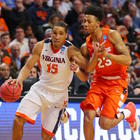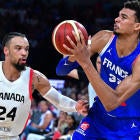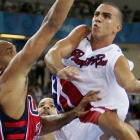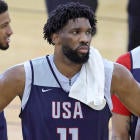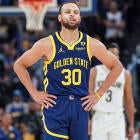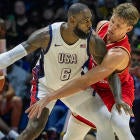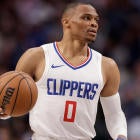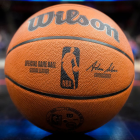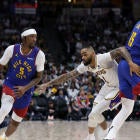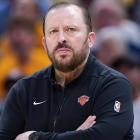Over the last five years, the NBA Draft's second round has become an invaluable resource for acquiring good players on long-term cheap contracts. One only has to look at 2011 for Isaiah Thomas and Chandler Parsons, 2012 for Draymond Green, 2013 for Allen Crabbe, 2014 for Nikola Jokic, and 2015 for Norman Powell.
This season is going to be no different, and in fact the second round may even be looked at in an even stronger light. With the NBA's salary cap rising and the draft salary structure staying the same, hitting in the second round has become one of the most profitable things an NBA team can do from an asset collection standpoint. The 2016 NBA Draft, in particular, has created a confluence of events that could make it even better than expected.
While this draft's first round is widely viewed in a negative light -- with the value of players being down across the board until you get to around the No. 25 spot or so -- the second round is mostly seen as being more solid than normal. In fact, realistically, there's not much difference on my board in the players ranked around No. 25 and No. 50. That's going to make this draft just an absolute mess to deal with. Around the league, the feeling is that it makes sense to just go get the guy you trust or like regardless of where his consensus value is. A "reach" in this draft isn't going to be the same as one in other drafts. Simply put, the value proposition is different.
That's what makes an exercise like this so valuable. Who are some of the players who are currently slotted as second round picks that I think teams could get a steal with? I've listed five for you below, and the key phrase here is mining role player talent. In the modern NBA, there are two things that are incredibly valuable from non-star players: wings who can both defend and score efficiently, and big men who rebound, protect the rim, catch lobs, and move well on the perimeter. In this NBA Draft, the wing position is rather scarce in the projected first round, but there are a few standouts as listed below who could do a little bit of everything as 6-foot-6 to 6-foot-9 players who provide versatility defensively and possibly some smart scoring offensively. There is also one big man here that any sort of analytical system loves due to his production at his age.
Malcolm Brogdon | SG | Virginia | No. 27 on the CBS Sports NBA Draft Big Board
Why he's likely to go in the second round: There are a few different questions that NBA evaluators have about Brogdon. Mostly though, it comes back to his athleticism. Is Brogdon explosive enough athletically to be the elite defender that he was in college? Will he be able to play efficiently on offense due to that lack of athleticism at the NBA level? Can he get to the rim at all? Will he get enough elevation on his jumper to shoot it successfully? It's also worth noting that there is some concern about Brogdon's jumper translating to the next level, as well. He hit 39 percent of his 3s this season, but the shot has a bit of a funky release and it can get relatively flat. Plus, at 23 years old, some believe there is a possibility that when he is no longer the strongest player on the floor in the NBA, he could struggle to do things successfully.
Why he could out-perform his slot: Brogdon is one of the more mature, intelligent players in this draft, and he works incredibly hard at his craft in terms of figuring out how to make things work despite his athleticism. His feel for the game is just remarkable. He knows exactly how to run tightly off of screens in order to get open off ball, and knows exactly how to get into a guy's grill in order to not let him get where he wants to go on the floor. He was the best defensive wing in college basketball last season, plus has an NBA-ready frame at 6-6 with a near 6-11 wingspan and weighing in at 223 pounds. Brogdon has solid skills as a secondary ball-handler, knows how to change pace with his dribble well, and he has shown that despite his mechanics he can knock down shots. The guy just knows how fall into a team concept, and seems destined to play an integral role as a wing on an NBA team.

Paul Zipser | F | Bayern Munich (Germany) | No. 30
Why he's likely to go in the second round: Zipser is the kind of player that it's hard to see much of an upside in beyond him being a solid role player -- a similar role to what he plays now in Munich. He's skilled in that he can shoot it well from deep, but he doesn't have much game in terms of creating his own shots. He'll hit shots and play off of closeouts, but he doesn't really have anything else beyond going in a straight line drive toward the rim on those closeouts. At 22, it's worth wondering what his upside and if he has as much room to grow as, say, a 19-year-old.
Why he could out-perform his slot: Everything about Zipser is tailor made for the NBA right now. He hits shots from deep and plays efficient basketball -- knocking down 42 percent of his 3s and throwing up a 62.7 true-shooting percentage. He has an NBA-ready frame at 6-8 with long arms, plus he's a great athlete who defends well. Basically, all of the little things that you want from a role player in the NBA, Zipser can provide them. He'll score despite not having plays run for him, he'll defend multiple positions, and he'll play smart basketball that you can trust. Maybe he's not a future star, but he can easily fit into an NBA role in a down draft.
Chinanu Onuaku | C | Louisville | No. 34
Why he's likely to go in the second round: There is a decent amount to like about Onuaku's game, but the negatives are glaring. Particularly, it's hard to see how he makes an impact offensively at this stage at the NBA level. He turns the ball over quite a bit due to trying to do too much on the offensive end, and doesn't really do much of anything away from the basket. He's also not necessarily the most explosive athlete, which wouldn't be a concern if not for the fact that he's probably an inch or two shorter than what you'd like your center to be. He might sneak into the back-end of the first round, but the second seems more likely.
Why he could out-perform his slot: Onuaku has a lot of what NBA teams want defensively from their centers now in his toolbox. He's a superb rebounder that threw up a 25.8 defensive rebounding rate this season. He's also strong, defends well in the post, protects the rim, and moves well for a player his size on the perimeter. Plus, while he's not yet an NBA player on the offensive end, there was certainly a lot of room for growth there in 2016. He nearly tripled his per-minute scoring average, showed off way more skill passing the ball than ever before, and looked competent at points as a screen-setter and diver in the pick-and-roll. Finally, Onuaku is a sophomore that doesn't turn 20 until Nov. 1, which means he definitely has some room to grow still. Again, Onuaku isn't a future star player, but he's the kind of guy that you might be able to groom into a great role playing center who does a lot of dirty work for your team.

Michael Gbinije | G/F | Syracuse | No. 45
Why he's likely to go in the second round: Gbinije led Syracuse on its run toward the Final Four this year, putting together one of the more well-rounded seasons in college hoops this year due to his shooting, scoring, and passing ability. However, he's one of the oldest players in the draft as he's already 24 years old after arriving to college a bit late then transferring from Duke to Syracuse. Combine that with the fact that he's not necessarily one of the most explosive guys and he pairs that with a relatively short wingspan, and it's easy to see why NBA teams have questions. Also, despite shooting 39 percent from 3 on nearly 400 attempts over the last two seasons, some NBA personnel still question whether or not he'll be consistent enough from deep due to funky, non-fluid mechanics.
Why he could out-perform his slot: Gbinije was one of the more productive players in college basketball for a reason. At 6-7, he had solid size for the the NBA to play either spot on the wing. Defensively, there will be an adjustment after playing in the zone at Syracuse, but he has the tools to be successful on that end of the floor. He has good hands, quick feet, and really competes on that end of the floor -- as he showed at the NBA Draft Combine. Even though there are questions about the shooting, it's worth remembering that he had to create so many of his own shots last season and might benefit from having a point guard next to him creating open looks for him. Given that he played point guard for Syracuse, Gbinije also has great ball-handling skills for a wing and could provide some versatility for teams. He's a really smart passer, and gets into the lane well. Basically, Gbinije does a lot of little things really well that could provide value to a team. The key will be the jump shot. If he can knock down shots from outside consistently like he showed in college, he'll be an NBA player.
Caris LeVert | G/F | Michigan | No. 51
Why he's likely to go in the second round: Realistically, there's only one reason why LeVert will probably go in the second round of this draft. There is significant concern about foot injuries that have plagued him over his basketball career. As a junior, he had a broken left foot -- an injury that had also occurred earlier in his career. Then, in his senior season, he suffered another injury that forced him to miss the last half of the year. It was a similar injury to what Kevin Durant had last year -- a Jones fracture that required surgery and now has forced him to miss working out for teams before the draft. Basically, the question here is whether or not teams can trust that the foot will be okay.
Why he could out-perform his draft slot: When LeVert is on the floor, he's clearly worth a first round pick in this draft. At 6-foot-7 with a solid wingspan, the Michigan wing is athletic and mobile with the ability to potentially defend multiple positions. It's on offense where he'll get the most out of his skills, though, as he has a well-rounded game. He handles the ball well, often acting as Michigan's primary creator when on the floor in college over his last two seasons. More than anything though, he's a terrific shooter who has hit over 40 percent of his 3s in each of the last three seasons. There is a lot of potential for a steal here if LeVert can stay healthy. At this stage though, that's a pretty significant question.









